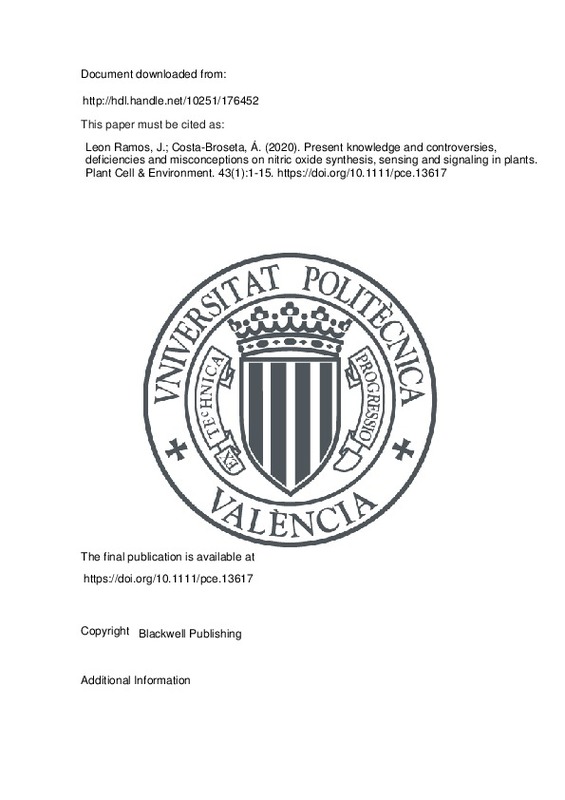JavaScript is disabled for your browser. Some features of this site may not work without it.
Buscar en RiuNet
Listar
Mi cuenta
Estadísticas
Ayuda RiuNet
Admin. UPV
Present knowledge and controversies, deficiencies and misconceptions on nitric oxide synthesis, sensing and signaling in plants
Mostrar el registro sencillo del ítem
Ficheros en el ítem
| dc.contributor.author | LEON RAMOS, JOSE
|
es_ES |
| dc.contributor.author | Costa-Broseta, Álvaro
|
es_ES |
| dc.date.accessioned | 2021-11-05T14:11:18Z | |
| dc.date.available | 2021-11-05T14:11:18Z | |
| dc.date.issued | 2020-01 | es_ES |
| dc.identifier.issn | 0140-7791 | es_ES |
| dc.identifier.uri | http://hdl.handle.net/10251/176452 | |
| dc.description.abstract | [EN] After 30 years of intensive work, nitric oxide (NO) has just started to be characterized as a relevant regulatory molecule on plant development and responses to stress. Its reactivity as a free radical determines its mode of action as an inducer of posttranslational modifications of key target proteins through cysteine S-nitrosylation and tyrosine nitration. Many of the NO-triggered regulatory actions are exerted in tight coordination with phytohormone signaling. This review not only summarizes and updates the information accumulated on how NO is synthesized, sensed, and transduced in plants but also makes emphasis on controversies, deficiencies, and misconceptions that are hampering our present knowledge on the biology of NO in plants. The development of noninvasive accurate tools for the endogenous NO quantitation as well as the implementation of genetic approaches that overcome misleading pharmacological experiments will be critical for getting significant advances in better knowledge of NO homeostasis and regulatory actions in plants. | es_ES |
| dc.description.sponsorship | Ministerio de Ciencia e Innovacion, Grant/Award Numbers: BIO2014-56067-P and BIO2017-82945-P; Government of Spain MINECO, Grant/Award Numbers: BIO2017-82945-P and BIO2014-56067-P | es_ES |
| dc.language | Inglés | es_ES |
| dc.publisher | Blackwell Publishing | es_ES |
| dc.relation.ispartof | Plant Cell & Environment | es_ES |
| dc.rights | Reserva de todos los derechos | es_ES |
| dc.subject | Nitration | es_ES |
| dc.subject | Nitric oxide | es_ES |
| dc.subject | Phytohormones | es_ES |
| dc.subject | Posttranslational modifications | es_ES |
| dc.subject | Sensing | es_ES |
| dc.subject | Signaling | es_ES |
| dc.subject | S-nitrosylation | es_ES |
| dc.subject | Synthesis | es_ES |
| dc.title | Present knowledge and controversies, deficiencies and misconceptions on nitric oxide synthesis, sensing and signaling in plants | es_ES |
| dc.type | Artículo | es_ES |
| dc.identifier.doi | 10.1111/pce.13617 | es_ES |
| dc.relation.projectID | info:eu-repo/grantAgreement/AEI/Plan Estatal de Investigación Científica y Técnica y de Innovación 2013-2016/BIO2017-82945-P/ES/TOLERANCIA AL OXIGENO Y AL OXIDO NITRICO TRAS HIPOXIA EN ARABIDOPSIS/ | es_ES |
| dc.relation.projectID | info:eu-repo/grantAgreement/MINECO//BIO2014-56067-P/ES/CONTROL DE LA PRODUCCION, PERCEPCION Y SEÑALIZACION DE NO POR MODIFICACIONES POSTRADUCCIONALES Y PROTEOLISIS DIRIGIDA POR LA SECUENCIA AMINOTERMINAL/ | es_ES |
| dc.rights.accessRights | Abierto | es_ES |
| dc.contributor.affiliation | Universitat Politècnica de València. Instituto Universitario Mixto de Biología Molecular y Celular de Plantas - Institut Universitari Mixt de Biologia Molecular i Cel·lular de Plantes | es_ES |
| dc.description.bibliographicCitation | Leon Ramos, J.; Costa-Broseta, Á. (2020). Present knowledge and controversies, deficiencies and misconceptions on nitric oxide synthesis, sensing and signaling in plants. Plant Cell & Environment. 43(1):1-15. https://doi.org/10.1111/pce.13617 | es_ES |
| dc.description.accrualMethod | S | es_ES |
| dc.relation.publisherversion | https://doi.org/10.1111/pce.13617 | es_ES |
| dc.description.upvformatpinicio | 1 | es_ES |
| dc.description.upvformatpfin | 15 | es_ES |
| dc.type.version | info:eu-repo/semantics/publishedVersion | es_ES |
| dc.description.volume | 43 | es_ES |
| dc.description.issue | 1 | es_ES |
| dc.identifier.pmid | 31323702 | es_ES |
| dc.relation.pasarela | S\433237 | es_ES |
| dc.contributor.funder | MINECO | es_ES |
| dc.contributor.funder | Ministerio de Economía, Industria y Competitividad | es_ES |







![[Cerrado]](/themes/UPV/images/candado.png)

